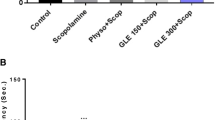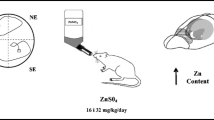Summary
In the present study the behavioural effects of Cerebrolysin® (Cere), a peptidergic nootropic drug, and E021, the concentrated peptide fraction of Cere, were investigated in 24-month-old rats. Rats passing a pretest to exclude motor-and eye-deficits were treated with either drugs or saline as control (2.5 ml/kg, intraperitoneally i.p.) for 19 days. Animals were tested in a standard Morris water maze on day 16 after pretest for 4 consecutive days (test days 1–4), eight trials per day. No significant differences of escape latency between males and females were found, therefore, results were pooled.
Both Cere and E021 treated rats showed significant lower escape latencies than saline treated controls on all four test days (p < 0.01). More pronounced effects of both drugs were found for female rats.
Female rats showed no significant differences in motor activity whereas drug treated males swam quicker on test day 1 (Cere p < 0.01; E021 P < 0.05) and day 2 (Cere p < 0.01).
In the present experiments it was demonstrated that i.p. administration of both Cere and E021 improves the spatial learning and memory of 24-monthold male and female rats.
Access this chapter
Tax calculation will be finalised at checkout
Purchases are for personal use only
Preview
Unable to display preview. Download preview PDF.
Similar content being viewed by others
References
Anger WK (1991) Animal test systems to study behavioral dysfunctions of neurode-generative disorders. NeuroToxicology 12: 403–414
Bartus RT (1979) Four stimulants of the central nervous system. Effects on short-term memory in young and aged rhesus monkeys. J Am Geriatr Soc 27: 289–297
Bartus RT, Dean RL, Beer B (1983) An evaluation of drugs of improving memory in aged monkeys. Implications for clinical trials in humans. Psychopharmacol Bull 19: 168–184
Boado RJ (1996) Brain-derived peptides increase the expression of a blood-brain barrier GLUT1 glucose transporter gene. Neurosci Lett 220: 53–56
Boado RJ, Wu D, Pardridge WM, Windisch M (1997) In vivo administration of brain-derived peptides increases the transport of glucose from blood to brain. J Neurol Sci 150: 77
Bubenzer R (1989) Alzheimer — eine Alterserscheinung? Therapiewoche 39: 2582–2584
Collier TJ, Coleman PD (1991) Divergence of biological and chronological aging: evidence from rodent studies. Neurobiol Aging 12: 685–693
Dwyer BE, Fando JL, Wasterlain CG (1980) Rat brain protein synthesis declines during postdevelopmental aging. Int Soc Neurochem 35: 746–749
Francis-Turner L, Valouskova V (1996) Nerve growth factor and nootroppic drug Cere but not fibroblast growth factor can reduce spatial memory impairment elicited by fimbria-fornix transection: short-term study. Neurosci Lett 202: 193–196
Gage FH, Dunnet SB, Björklund A (1984a) Spatial learning and motor deficits in aged rats. Neurobiol Aging 5: 43–48
Gage FH, Kelly PAT, Björklund A (1984b) Regional changes in brain glucose metabolism reflect cognitive impairments in aged rats. J Neurosci 4: 2856–2865
Gschanes A (1995b) The influence of Cerebrolysin and E021 on spatial navigation of young and adult rats. Internal report
Gschanes A (1997c) The influence of cerebrolysin and E021 on spatial navigation of adult rats. Internal report
Gschanes A, Windisch M (1997a) The influence of brain-derived peptides on spatial navigation of young and adult rats. 27th Annual Meeting of the Society for Neuroscience, New Orleans, Abstract 171.11
Gschanes A, Valouskova V, Windisch W, Xiong H (1995a) The effects of NGF, b-FGF and Cerebrolysin on spatial navigation after bilateral lesions of the sensorimotor cortex. 25th Annual Meeting of the Society for Neuroscience, San Diego, Abstract 823.8
Gschanes A, Valouskova V, Windisch M (1997b) Ameliorative influence of a nootropic drug on motor activity of rats after bilateral carotid artery occlusion. J Neural Transm 104: 1319–1327
Hutter-Paier B, Frühwirth M, Grygar E, Windisch M (1996a) Cerebrolysin protects neurons from ischemia-induced loss of microtubule-associated protein 2. J Neural Transm 47: 176
Hutter-Paier B, Grygar E, Windisch M (1996b) Death in cultured telencephalon neurons induced by glutamate is reduced by the peptide derivative Cerebrolysin. J Neural Transm 47: 267–273
Hutter-Paier B, Eggenreich U, Windisch M (1996c) Effects of two protein-free peptide derivates on passive avoidance behaviour of 24-month-old rats. Arzneimittel-forschung/Drug Res 46: 237–241
Hutter-Paier B, Eggenreich U, Windisch M (1996d) Dose-dependent behavioural effects of two protein-free peptide derivates on the passive avoidance reaction of rats. Arzneimittelforschung/Drug Res 46: 242–246
Hock FJ (1987) Drug influences on learning and memory in aged animals and humans. Neuropsychobiology 17: 145–160
Lindner G, Grosse G, Matthies H, Kirsche W (1975) Über die Wirkung von Hirnextrakt und-hydrolysat auf das Nervengewebe unter In-vitro Bedingungen. Z Mikrosk Anat Forsch 89: 815–823
O’Steen WK, Spencer RL, Bare DJ, McEwen BS (1995) Analysis of severe photoreceptor loss and Morris water-maze performance in aged rats. Behav Brain Res 68: 151–158
Orlanow C, Arendash G (1994) Metals and free radicals in neurodegeneration. Curr Opin Neurol 7: 548–558
Paier B, Windisch M, Eggenreich U (1992) Postnatal administration of two peptide solutions affect passive avoidance behaviour of young rats. Behav Brain Res 51: 23–28
Piswanger A, Paier B, Windisch M (1990) Amino acids. Escom, Leiden, pp 651–657
Rapp PR, Rosenberg RA, Gallagher M (1987) An evaluation of spatial information processing in aged rats. Behav Neurosci 101: 3–12
Rüther E, Ritter R, Apecechea M, Freytag S, Windisch M (1994) Efficacy of the peptidergic nootropic drug Cerebrolysin in patients with senile dementia of the Alzheimer type (SDAT). Pharmacopsychiatry 27: 32–40
Sack CA, Socci DJ, Blane M, Crandall M, Arendash GW (1996) Antioxidant treatment with phenyl-α-tert-butyl nitrone (PBN) improves the cognitive performance and survival of aging rats. Neurosci Lett 205: 181–184
Satou T, Itoh T, Fujimoto M, Hashimoto S (1994) Neurotrophic-like effects of FPF-1070 on cultured neurons from chick embryonic dorsa root ganglia. Jpn Pharmacol Ther 22/4: 205–212
Schaller R, Schwab M, Bauer R (1993) EEG analysis and comparison to morphological changes after hypoxic ischemic brain injury in rats: In: Rother M, Zwiener U (eds) Quantitative EEG analysis — clinical utility and new methods. Universitätsverlag Jena, Jena, pp 240–244
Schwab M, Bauer R, Zwiener U (1993) Quantitative and topological EEG and MEG analysis. Universitätsverlag Jena, Jena, pp 243–247
Schwab M, Schaller R, Bauer R, Zwiener U (1997) Morphofunctional effects of moderate forebrain ischemia combined with short-term hypoxia in rats — protective effects of Cerebrolysin. Exp Toxic Pathol 49: 29–37
Schwab M, Bauer R, Zwiener U (1997) Physiological effects and brain protection by hypothermia and Cerebrolysin after moderate forebrain ischemia in rats. Exp Toxic Pathol 49: 105–116
Shimazu SN, Tachikawa N, Iwamoto D, Itho T, Komatsu S, Fujimoto M (1992) The neurotrophic and brain protein effect of Cerebrolysin. Neurobiol Aging 13: 107–113
Sugita Y, Kondo T, Kanazawa A, Itou T, Miyuone Y (1993) Protective effects of FPF 1070 (Cerebrolysin) on delayed neuronal death in the gerbil. Detection of hydroxyl radicals with salycylic acid. Brain Nerve 45: 329–331
Valouskova V, Francis-Turner L, Gschanes A (1997) Long-term changes after the fimbria-fornix lesion followed by bFGF, NGF and cerebrolysin treatment. 27th Annual Meeting of the Society for Neuroscience, New Orleans, Abstract 572.2
Vereshagin NV, Nekrasova YM, Lebedova NV, Suslina ZA, Solviev OI, Priadov MA, Altunina M (1991) Mild forms of multi-infarct dementia: efficacy of cerebrolysin. Sov Med 11: 1–6
Wenzel J, Stender G, Duwe G (1981) Zur Entwicklung der Neuronenstruktur der Fascia dentata bei der Ratte. Neurohistologisch-morphometrische, ultrastrukturelle und experimentelle Untersuchungen. J Hirnforsch 22: 629–683
Windisch M (1996) Possible implication of neurotrophic fators in treatment of neurodegenerative disorders. Clin Neurosci 49: 28–29
Windisch M, Piswanger (1985c) In vitro effects of peptide derivates and extracts from calf blood on the oxidative metabolism of brain, liver and heart muscle homogenates of the rat. Drug Res 35: 87–89
Windisch M, Paier B, Eggenreich U (1994) Neuronal growth factors and their role in degenerative brain diseases: a mini-review. Neurol Croat 43/2: 9–20
Author information
Authors and Affiliations
Editor information
Editors and Affiliations
Rights and permissions
Copyright information
© 1998 Springer-Verlag Wien
About this paper
Cite this paper
Gschanes, A., Windisch, M. (1998). The influence of Cerebrolysin® and E021 on spatial navigation of 24-month-old rats. In: Jellinger, K., Fazekas, F., Windisch, M. (eds) Ageing and Dementia. Journal of Neural Transmission. Supplementa, vol 53. Springer, Vienna. https://doi.org/10.1007/978-3-7091-6467-9_27
Download citation
DOI: https://doi.org/10.1007/978-3-7091-6467-9_27
Publisher Name: Springer, Vienna
Print ISBN: 978-3-211-83114-4
Online ISBN: 978-3-7091-6467-9
eBook Packages: Springer Book Archive




